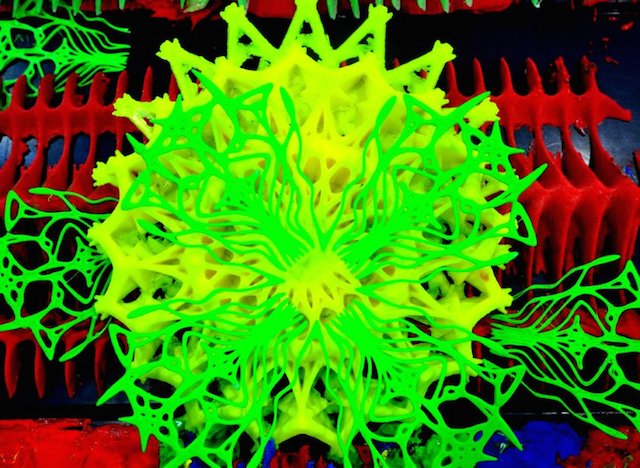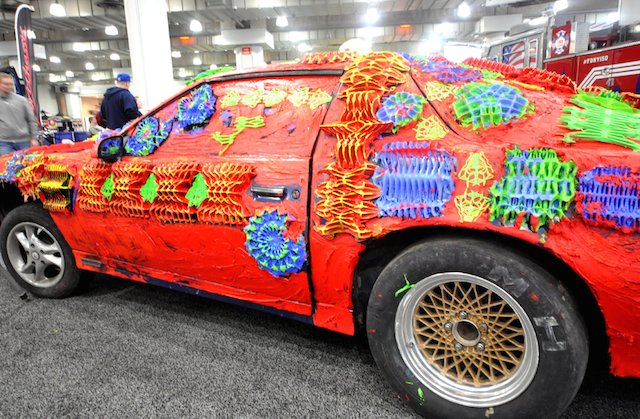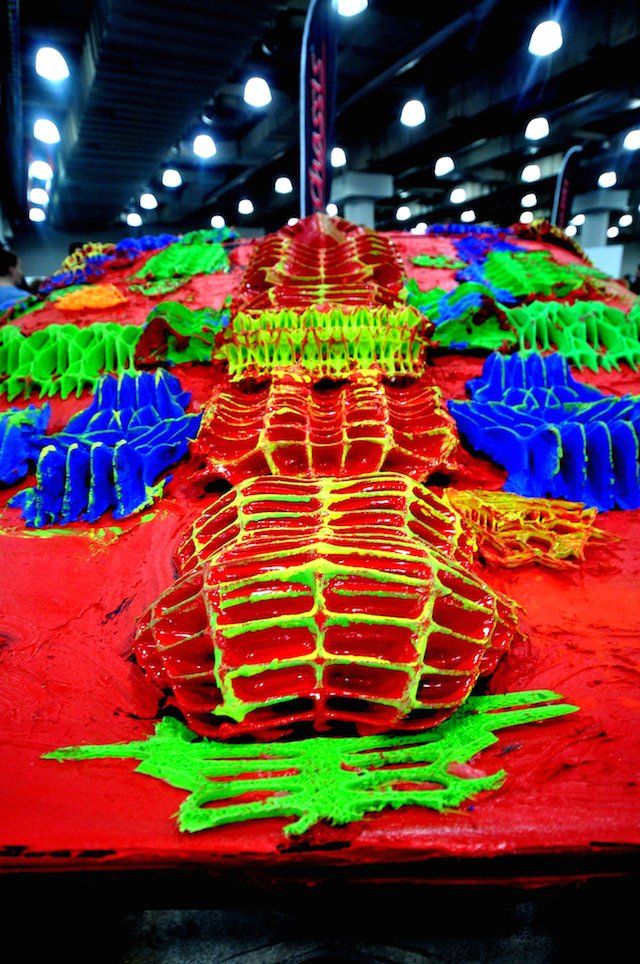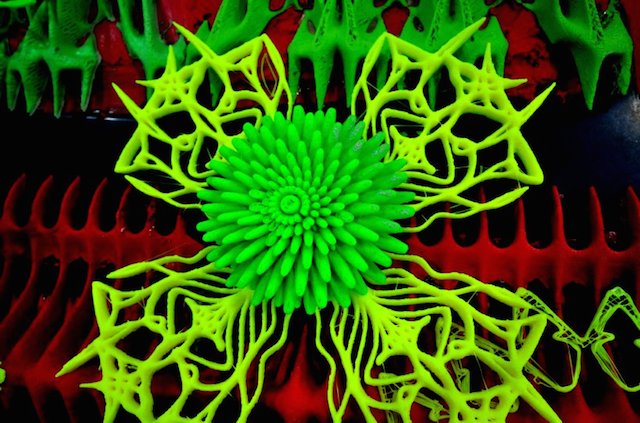Images courtesy the artist
A Chevy Camaro gets tricked out with zigzagging 3D-printed pigments and patterns in Ioan Florea’s newest 3D-printed masterpiece, presented at New York’s International Auto Show. Florea, a self-described “digital archeologist,” excavates the coded underbelly of cyberverse for intricate 3D shapes. With this readymade arsenal of digital designs, Florea then demonstrates numeric code’s unexpected aesthetics by converting functional objects—cars, washing machines, and even entire homes—into spectacular large-scale sculptures.In light of his new work, there is little wonder why the Romanian-born artist has been called the “Wizard” of 3D printing. At last year’s Auto Show, for example, the artist also caused quite a stir in the 3D community, traveling from Illinois to the show’s venue in New York with a 3D-printed mobile home in tow. Once he arrived, the artist rolled out a 3D printed liquid metal Ford Gran Torino, gleaming in metallic, otherworldly designs. Much like his Torino, Florea’s colorful Camaro blends his “digital archeology” with the practice of readymade art. “For me,” Florea tells the Creators Project, “the car is an industrial, ready-made, functional object that I turn into [a] nonfunctional object of art.” The bright, almost biological topography of the car further emphasizes Florea’s method with a metaphorical flare: “The car looks like [it] was brought up from the bottom of the ocean,” he explains, while, at the same time, the designs themselves have been “brought up” from bottom of his computer.
Much like his Torino, Florea’s colorful Camaro blends his “digital archeology” with the practice of readymade art. “For me,” Florea tells the Creators Project, “the car is an industrial, ready-made, functional object that I turn into [a] nonfunctional object of art.” The bright, almost biological topography of the car further emphasizes Florea’s method with a metaphorical flare: “The car looks like [it] was brought up from the bottom of the ocean,” he explains, while, at the same time, the designs themselves have been “brought up” from bottom of his computer. In creating the Camaro, Florea first found and designed the imagery and 3D shapes through digital manipulation of numeric code. Then, creating his own 3D filament by mixing clear ABS with specialized automotive pigments, he turned his discovered shapes into GCode and started the laborious printing process. “I [had] two 3D printers on the floor,” he explains, “creating shapes that [were] incorporated on the Camaro continuously.”
In creating the Camaro, Florea first found and designed the imagery and 3D shapes through digital manipulation of numeric code. Then, creating his own 3D filament by mixing clear ABS with specialized automotive pigments, he turned his discovered shapes into GCode and started the laborious printing process. “I [had] two 3D printers on the floor,” he explains, “creating shapes that [were] incorporated on the Camaro continuously.” In order to incorporate his designs onto the car’s uneven surface, Florea decided upon the reliable materials of nanoclay and nanopigments. “The nanoclay has the capacity to create internal tridimensional structures at the nano-level,” he says, allowing it to self-regulate and organizing its own material behavior. The pigment works alongside the clay, setting the pristine alignments and helping the structures retain their form.
In order to incorporate his designs onto the car’s uneven surface, Florea decided upon the reliable materials of nanoclay and nanopigments. “The nanoclay has the capacity to create internal tridimensional structures at the nano-level,” he says, allowing it to self-regulate and organizing its own material behavior. The pigment works alongside the clay, setting the pristine alignments and helping the structures retain their form. With his most recent creation still practically cooling, Florea says he's already begun his next phase of printing. The artist wants to continue exploring readymade digital imagery by focusing his talents onto a much smaller scale with a series of 3D-printed, pigment-fused deposition paintings—the "supertextural" opposite of Murakami's superflat artworks, the artist explains in a press release.As for his long-term goals, Florea has much grander plan: to “build a farm of open source 3D printers to be able to bring to light the thousands of shapes” that are just waiting to be discovered, he says, at the depths of his hard drive.
With his most recent creation still practically cooling, Florea says he's already begun his next phase of printing. The artist wants to continue exploring readymade digital imagery by focusing his talents onto a much smaller scale with a series of 3D-printed, pigment-fused deposition paintings—the "supertextural" opposite of Murakami's superflat artworks, the artist explains in a press release.As for his long-term goals, Florea has much grander plan: to “build a farm of open source 3D printers to be able to bring to light the thousands of shapes” that are just waiting to be discovered, he says, at the depths of his hard drive. Related:"Texture" Turns The Internet Into An Alien LandscapeFeast Your Eyes On These Macroscopic 3D TopographiesNeon Paint Experiment Visualizes High-Speed Ferrari Physics
Related:"Texture" Turns The Internet Into An Alien LandscapeFeast Your Eyes On These Macroscopic 3D TopographiesNeon Paint Experiment Visualizes High-Speed Ferrari Physics
Advertisement


Advertisement


